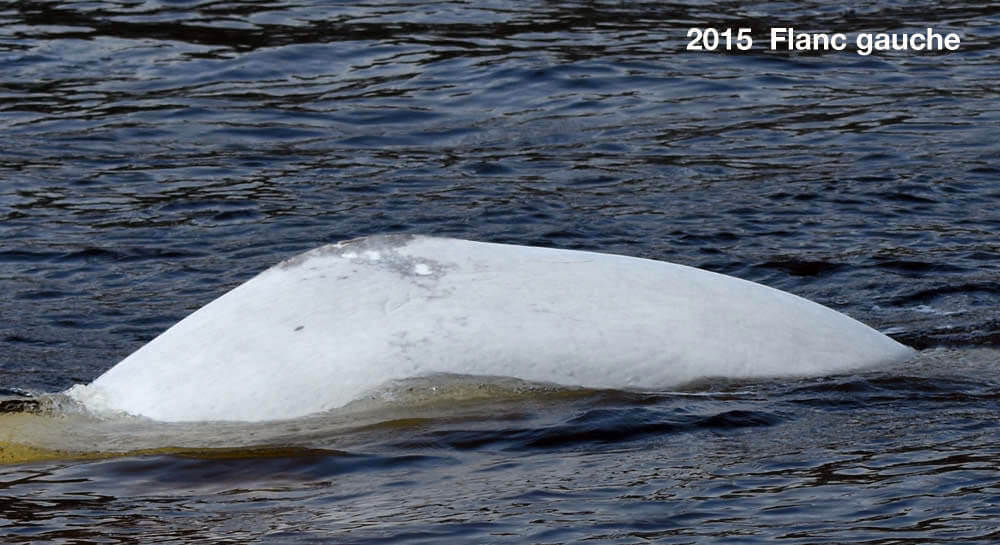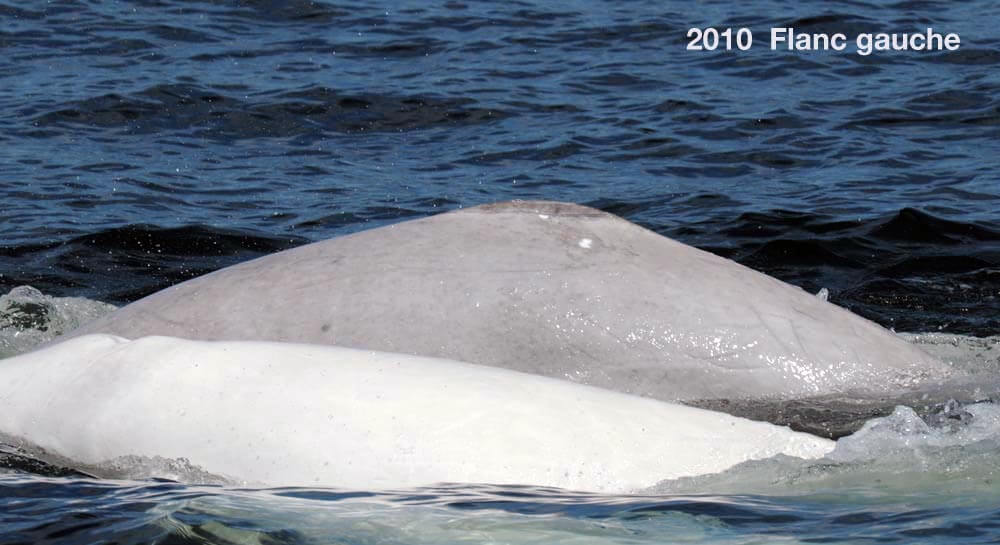Delphi
Beluga


Adopted by Philippe Couillard, Premier of Québec
-
ID number
DL2505
-
Sex
Unknown
-
Year of birth
Around 2000
-
Known Since
2006
Distinctive traits
Delphi is easily identifiable from its left flank : a large gray patch and white dots completely cover its dorsal crest and continue down its flank.
Life history
We first met Delphi in 2006. It was then a very young dark gray beluga. We are unable to determine its exact age. Beluga whales change color from gray to white between the ages of 12 and 16. Delphi would therefore have been born around 2000.
Its small size and regular presence in herds of females and calves suggest that Delphi is a female and belongs to the Saguenay community. In the summer range, females form large communities in which they look after newborns and young. These communities are attached to traditional territories, and there is little exchange between them.
Its companions include Miss Frontenac, Athéna, Blanche and Céline. Associations between females in the same community are generally not stable. They can vary according to the reproductive state of the females, for example whether or not they are pregnant or accompanied by a youngster.
The rest of Delphi’s story will help us to better understand the social and reproductive life of belugas. By understanding how belugas live, we can better protect them.
Observations history in the Estuary
Years in which the animal was not observed Years in which the animal was observed
Latest news
Aboard Le Bleuvet, we welcome Fisheries and Oceans Canada researcher Véronique Lesage. She is conducting a research project on the behavioral and communicative reactions of belugas in the presence of underwater noise. Today, we’re going to study the belugas present in the Saguenay. We head upriver to L’Anse-Saint-Jean, where we find a herd of around 30 belugas. Just over half of them are gray, and therefore young. Surrounding our research boat and the belugas are three inflatable boats, three kayaks and a paddleboard. The boats are less than 400 metres from the belugas, and therefore not within the required distance. The belugas change direction and head for Sainte-Marguerite Bay. We photograph them on the move and recognize Delphi. As we follow them at a distance, a young beluga approaches our boat. We take the opportunity to place a tag on its back. Unfortunately, it slips off after two minutes.
Some twenty belugas swim not far from the Sainte-Marguerite Bay tower. Among them is Delphi. Adults and juveniles swim in two groups that mix and mingle. The animals spend little time on the surface, but when they come up, several stick out their tails. Could the animals be feeding? The hydrophone in the bay may be able to tell us, thanks to the calls it picks up. At the end of the contact, we manage to observe two calves.
We’re in the Saguenay Fjord, near Sainte-Marguerite Bay. We recognize Delphi. She’s swimming among a herd of some 30 individuals, including adults and juveniles, including a newborn. Sainte-Marguerite Bay seems to be a very special and important site for St. Lawrence belugas. It is located some twenty kilometers from the mouth of the river and is part of the Saguenay-St. Lawrence Marine Park (SSLMP). The function of the bay for beluga whales, particularly females and calves, is not yet well understood. The site could be a feeding, resting or socialization area for the young. It could even be a calving ground for females, like Delphi, but this hypothesis remains to be verified.
Sponsor
Delphi and Leucas were entrusted to the Right Honourable Justin Trudeau and the Honourable Philippe Couillard, respectively Prime Minister of Canada and Premier of Quebec, by Robert Michaud, GREMM’s Scientific Director, concerned about the survival of the belugas.
Prime Ministers, thank you for taking care of Delphi and Leucas
Mr Trudeau, Mr Couillard, allow me to introduce Delphi and Leucas. These are two belugas that I see every summer in the St. Lawrence. Both are less than 20 years old. Delphi is a female and should give birth to her first calf soon. Leucas is a male and spends his time weaving his social network. They belong to an “endangered” population and need your immediate help. If we share the St. Lawrence with them, they could live until 2080!
Our choices today shape the world in which they will live. It’s those choices I’d like to talk to you about. But first, let me tell you a little more about Delphi and Leucas.
Thanks to their distinctive markings, I’ve learned to recognize hundreds of belugas one by one. Over the years, I’ve gotten to know them. Over the years, they’ve told me their story, the story of the St. Lawrence, and a little of our story too.
Like us, belugas have colonized the St. Lawrence. Driven from the Arctic by the last ice age, they found refuge here 10,000 years ago. In 1535, Cartier wrote that many white porpoises lived in this great river called the St. Lawrence. Since then, their numbers have steadily declined, and the Fleuve aux Grandes Eaux has changed. These changes are accelerating, and with them, our concerns!
Never before have we been so aware of these changes. Never before have we had so much science to identify, understand, mitigate and perhaps reverse these changes.
When, in the 1930s, fishermen complained that belugas were decimating salmon and cod, we bombarded them. Until 1939, bounties were paid to hunters. This race to exterminate came to an end following a scientific study which concluded that cod and salmon were rarely eaten by belugas.
A few hundred belugas survived this exploitation to find themselves in the most toxic period of the St. Lawrence, at the heart of the industrial era. As a result of decades of efforts to improve the health of the St. Lawrence, contaminants banned in the early 1970s are now on the decline in belugas, and the cancers that killed a quarter of adult belugas have disappeared.
However, belugas have not been saved from the waters. Their population is once again in decline, and mortality among pregnant females and newborn calves is on the rise. According to the Species at Risk Act, an “endangered” population faces imminent extirpation or extinction if nothing is done to counteract the factors threatening its disappearance. And now, we can no longer plead ignorance.
Some of the threats facing belugas are difficult to reverse. Toxic leg, warming waters and collapsing fish stocks all deserve our attention, but it will take decades to correct the situation. Scientists who have been studying belugas for some thirty years agree : in the short term, our efforts must be directed towards eliminating anthropogenic stressors such as disturbance in sensitive areas.
To effectively protect the chorus frog, it wasn’t necessary to stop housing construction in Quebec, but only on a few hectares. To protect the St. Lawrence beluga whale, we don’t need to put all its essential habitat under a glass bell or close the seaway.
We know more and more about the habits and needs of belugas. We know that it’s not a good idea to develop port activity in Cacouna. Building new terminals in the Saguenay would also increase shipping traffic in a sensitive portion of the belugas’ critical habitat.
Once again, it would be unfortunate to pit belugas against economic development. Above all, it would be perilous to do so on a project-by-project basis. Like economic development, beluga protection needs a strategy. Otherwise, as so often happens, our economic development strategies will outpace our species-at-risk recovery strategies.
The creation of a network of acoustic refuges, in the form of marine protected areas or sanctuaries in which we avoid increasing human activity, could protect belugas. It would also enable us to better prepare for the future, by combining our aspirations for a better world, for belugas and for us. Protecting belugas can also be a source of pride and an engine for economic development.
In recent years, millions of visitors have come to meet the belugas in the Saguenay-St. Lawrence Marine Park. What’s more, thousands of Quebecers and Canadians, businesses and municipalities have symbolically “adopted” belugas, showing their attachment and giving us their support to better understand and protect them.
Mr. Trudeau, I’d like to entrust you with the care of Leucas. To you, Mr Couillard, I entrust Delphi. I promise to give you news of your protégés whenever I meet them. In exchange, I’d like you to work together quickly, as you did with the creation of the Saguenay-St. Lawrence Marine Park, to create the acoustic refuges that Delphi, Leucas and their families need.
I hope you will proudly tell the story of your protégés to your children and grandchildren, and that in 2080 they will still be able to marvel when they see a herd of belugas and recognize Delphi and Leucas.
Robert Michaud
Scientific Director, Group for Research and Education on Marine Mammals (GREMM)



